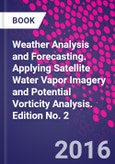Weather Analysis and Forecasting: Applying Satellite Water Vapor Imagery and Potential Vorticity Analysis, Second Edition, is a step-by-step essential training manual for forecasters in meteorological services worldwide, and a valuable text for graduate students in atmospheric physics and satellite meteorology. In this practical guide, P. Santurette, C.G. Georgiev, and K. Maynard show how to interpret water vapor patterns in terms of dynamical processes in the atmosphere and their relation to diagnostics available from numerical weather prediction models. In particular, they concentrate on the close relationship between satellite imagery and the potential vorticity fields in the upper troposphere and lower stratosphere. These applications are illustrated with color images based on real meteorological situations over mid-latitudes, subtropical and tropical areas.
Please Note: This is an On Demand product, delivery may take up to 11 working days after payment has been received.
Table of Contents
Part I: Fundamentals 1. A dynamical view of synoptic development 2. The interpretation problem of satellite water vapor imagery
Part II: Practical use of water vapor imagery and thermodynamical fields 3. Significant water vapor imagery features associated with synoptic thermodynamic structures 4. Diagnosis of thermodynamic environment of deep convection 5. Use of water vapor imagery to assess NWP model behavior and to improve weather forecasts
Appendix A. Radiation measurements in water vapor absorption band Appendix B. PV modification technique and PV inversion to correct the initial state of the numerical model








